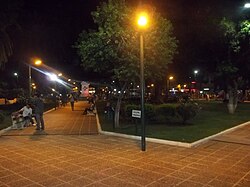Tartagal | |
|---|---|
 | |
| Coordinates: 22°30′S 63°50′W / 22.500°S 63.833°W | |
| Country | |
| Province | |
| Department | San Martín |
| Founded | 1924 |
| Government | |
| • Mayor | Sergio Napoleón Leavy (Partido Frente para la Victoria) |
| Area | |
• Total | 3,015 km2 (1,164 sq mi) |
| Elevation | 490 m (1,610 ft) |
| Population (2010 census) | |
• Total | 63,196 |
| • Density | 21/km2 (54/sq mi) |
| Time zone | UTC-3 (ART) |
| CPA base | A4560 |
| Dialing code | +54 3875 |
| Climate | Cwa |
| Website | Tartagal website |
Tartagal (Spanish pronunciation: [taɾtaˈɣal]) is a tropical city in northern Argentina, in the province of Salta. It is located in the northeast of the province, within the General José de San Martín Department, of which it is the capital. It is located in the Yungas jungle, at the foot of the sub-Andean mountain ranges to the west and the Salta plains to the east. This location gives it a wide variety of flora and fauna, and its territory is home to eight indigenous communities. It stands out for the large density of large trees in its streets and squares, such as mangoes, algarrobos and lapachos. It is one of the few places in the world where the green macaw is not extinct in the wild.
Due to its economy, it is the third most important city in the province, after Orán. It stands out as a center for oil and gas extraction, and also has strong activity in the forestry and agricultural sectors.
It is located 365 km from the provincial capital, Salta, 57 km from the border with Bolivia (so it is considered a border city), 103 km from the border with Paraguay, and 1736 km from Buenos Aires. Tartagal is connected to the rest of the province and the country through National Route 34, National Route 86 and through the General Mosconi airport, although the latter does not receive commercial flights at present.
Tartagal houses a regional headquarters of the National University of Salta and the Catholic University of Salta. It also has learning centers from the Siglo 21 and Blas Pascal universities.

